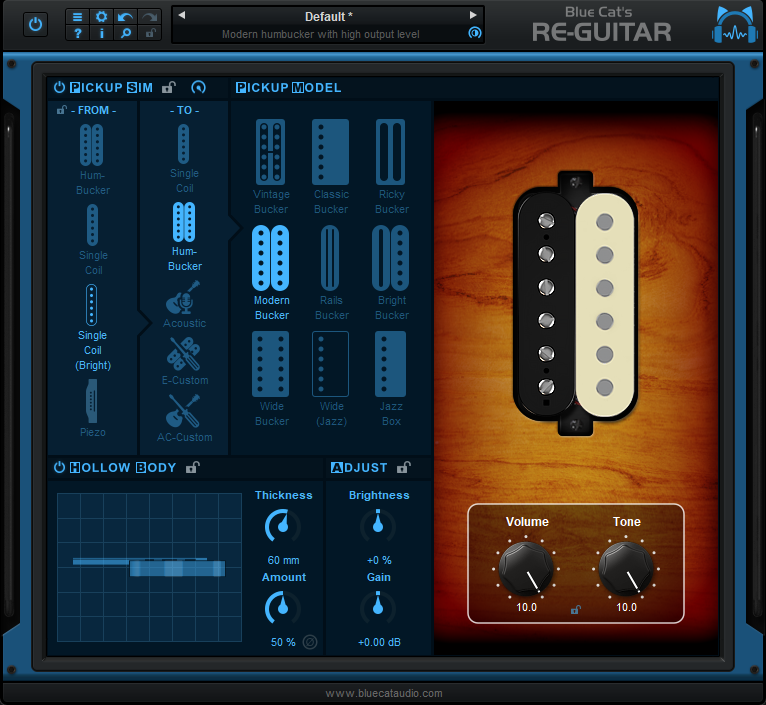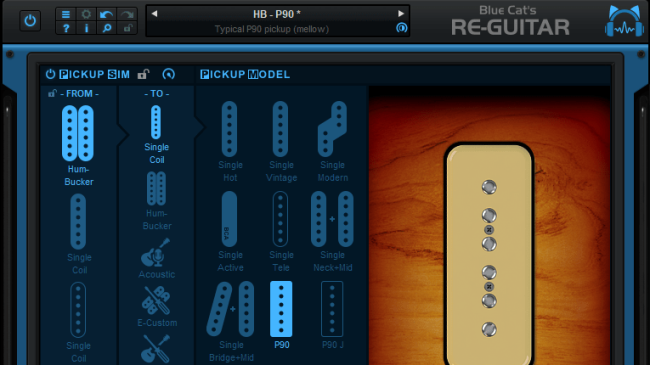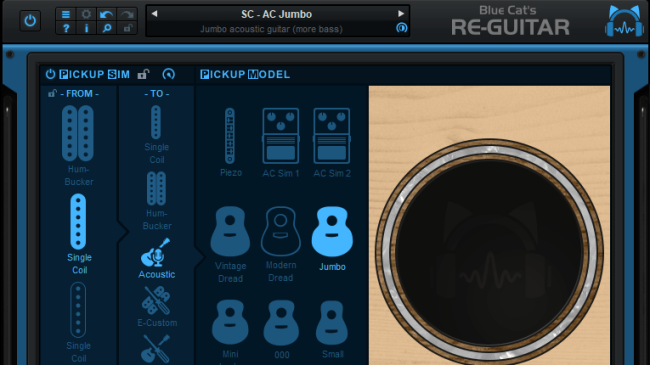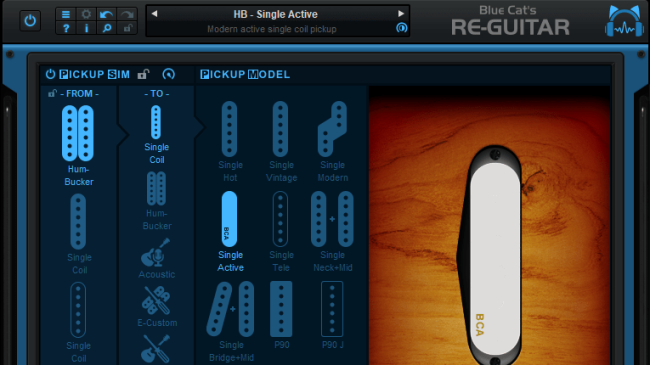Table Of Content
Introduction
Welcome to the world of "Re-Guitaring": enjoy an infinite number of guitar tones out of a single instrument!
With Re-Guitar, you can emulate many kinds of guitar tones (electric or acoustic), regardless of the guitar model used for recording: keep playing your own guitar and get all the sounds that you like, and more!
The built-in pickup simulator lets you emulate many types of electric guitar pickups without the need to modify your favorite instrument: choose from a selection of popular guitar pickups or create your own.
You can also dig and expand the body "in the box" to craft your own hollow body guitar tone thanks to the body simulator.
The plug-in includes a selection of acoustic guitar simulations, and you can craft your own too.
In addition to the brightness and gain adjustements, the virtual tone and volume pots let you tweak the tone in details. They can even be automated to follow the performance.
If you do not play guitar but are producing music with recorded guitars, you will enjoy "re-guitaring" too: you can now "fix it in the mix" and virtually switch guitars after recording!
The plug-in can also be applied to enhance the sound of acoustic or electric guitars with piezo pickups (acoustic simulations only).
This plug-in is also available as a built-in effect inside Blue Cat's Axiom, the multi effects processor for guitar and bass.
System Requirements
MacOS
- An Intel or Apple Silicon processor.
- Mac OS 10.9 or newer.
- Any VST / Audio Unit / AAX compatible application (64-bit) .
Windows
- An SSE2-enabled processor (Pentium 4 or newer).
- Microsoft Windows Vista, Windows 7, 8 or 10.
- Any VST / AAX compatible host software (32 or 64 bit).
For more information about supported platforms, see our Knowledge Base.
Demo Limitations:
- 5 instances of the plug-in allowed per session.
- The effect is bypassed for half a second every minute.
Installation
The plug-ins versions cannot be run standalone: they require a host application (see the System Requirements chapter for more information). Depending on which host application you use, you might need to install the plug-ins in different locations.
Before installing one of the plug-in versions, you should close all your host applications.
Windows
Install
All versions of the plug-in provide an installation program. Follow the steps of the wizard to install the software on your machine. During the installation you will be asked where you want the software to be installed. For the VST version, you should install the plug-in inside the VST plug-ins folder used by your host application(s). The default path set in the installer should work for most applications, but you should check your host software documentation to know where it looks for VST plug-ins. For other plug-in types, you should just use the standard path.
Some applications will not automatically rescan the new plug-ins, so you might have to force a refresh of the plug-ins list.
Upgrade
When a new version of the software is released, just launch the new installer: it will update the current installation.
Uninstall
To uninstall the software, simply launch the "Uninstall" program that is available in the start menu or in the configuration panel. It will take care of removing all files from your computer.
Mac
Install
On Mac the plug-ins are available as drive images with an installer. After download, double click on the dmg file to open it. You can then double click on the installer (.pkg file) to install the package.
Note for Mac OS 10.15 Catalina or newer: you may have to right click on the installer and select "Open" instead of double clicking on the file to launch the installation if your computer is not connected to the Internet.
Upgrade
When a new version of the software is released, just launch the new installer: it will update the current installation.
Uninstall
To uninstall the software, simply remove the component(s) from their install location (move them to the trash):
- AAX plug-ins are installed in the /Library/Application Support/Avid/Audio/Plug-Ins/ folder
- Audio Units (AU) are installed in the /Library/Audio/Plug-Ins/Components/ folder
- RTAS Plug-ins are installed in the /Library/Application Support/Digidesign/Plug-Ins/ folder
- VST plug-ins are installed in the /Library/Audio/Plug-Ins/VST folder
- VST3 plug-ins are installed in the /Library/Audio/Plug-Ins/VST3 folder
If you want to completely remove all settings and configuration files, you can also remove these additional directories that may have been created on your computer:
- ~/Library/Preferences/Blue Cat Audio/[Plug-in name and TYPE], where TYPE is VST, AU, RTAS or AAX: global preferences.
- ~/Library/Preferences/Blue Cat Audio/[Plug-in name]: license information
- ~/Documents/Blue Cat Audio/[Plug-in name]: user data, such as presets, additional skins and user-created plug-in data.
Please be aware that these directories may contain user data that you have created. Remove these directories only if you do not want to reuse this data later.
First Launch
Blue Cat Audio plug-ins cannot be run standalone, they require a host application (see the System Requirements chapter for more information). Some host applications will require you to scan the plug-ins before they are available in the application.
If the plug-in is not available in the application, please check that it has been installed in the appropriate directory (with no host application running), and that the host application has scanned it.
Using Blue Cat's Re-Guitar
The User Interface
Note: The main toolbar, menus and basic features available with all our plug-ins are detailed in the Blue Cat Audio Plug-ins Basics section.
Main Components
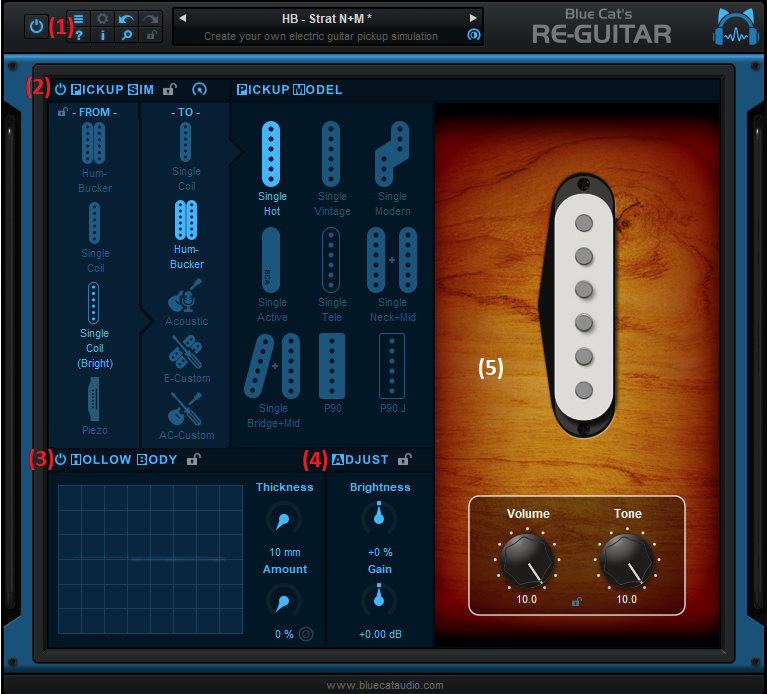
- The main toolbar, for bypass, general plug-in functions and presets management (described later in the manual).
- Pickup and acoustic guitar simulation.
- Hollow body simulation, with thickness and amount controls.
- Brightness and gain adjustments.
- Guitar preview section, with virtual volume and tone pots.
Selecting a Simulation
- Select the source pickup type (the pickup used on your guitar - for an acoustic guitar, use piezo).
- Select the type of simulation.
- Select the actual simulation (pickup or acoustic guitar).
- You can adjust the amount of dry guitar pickup vs simulation using the pickup mix knob at the top.

You can also click on "FROM" and "TO" or the pickup shown in the preview window to select the pickups from a dropdown menu. Once one of these elements is selected you can also use the mouse wheel or keyboard arrows to perform the selection.
Custom Simulations
When selecting "E-Custom" or "AC-Custom" you can create your own simulations by navigating with a cursor (green) between the predefined pickup or acoustic guitar simulations:

Zoom: use the mouse wheel or double click on the cursor to adjust the zoom level to make precise adjustments. Once zoomed, you can drag the background to navigate in the map. Right click on the background to unzoom.
Locks
Several locks are available to prevent changes while loading presets: when the lock is active, loading presets will not change the parameters of a locked section. A general UI lock is also available in the toolbar, if you want to keep the same user interface settings (window opacity...).
You may typically want to lock the input pickup type and "adjust" sections while loading presets so that presets work with your current guitar. Sometimes you may also want to lock the virtual pots if you just want to switch pickups and hollow body while retaining the current pots settings.
Using the Controls
The various elements of the user interface (knobs, sliders, buttons...) are simple and intuitive to operate, but more information about how to interact with them is available in the "Plug-ins Basics" chapter of this manual.
Operation
Getting Started: Re-Guitaring Where?
Since the Re-Guitar plug-in modifies the tone of the guitar, it should be placed first in the signal chain, before any other effect or pedal (including compressors, distortion pedals etc.).
So if you are using it as an insert in your DAW, place it at the first position in the plug-ins chain, on a guitar track that was recorded direct, without any pedal or amplifier. Amp simulation and effects plug-ins should be placed after Re-Guitar.
If you are using Re-Guitar as a built-in plug-in inside Axiom, insert it as the first element in the INPUT FX bin. Tip: did you know that you can lock the INPUT effects bin so that the settings of the Re-Guitar plug-in are kept while loading Axiom presets?
Getting Started: Calibration
Before using the custom pickups simulations, it is recommended to calibrate the plug-in, in order to adapt to your specific pickups. You will still be able to adjust the settings later to reach the desired sound, but it will give you a good starting point:
- Make sure that hollow body simulation is off, and that tone and volume pots are set to their maximum value on both the guitar and plug-in.
- Select the input pickup type that corresponds to the current pickup on your guitar.
- Select the virtual pickup that corresponds to the pickup in use on your guitar (the closest model). When using an acoustic guitar, use the piezo pickup for both from and to.
- Adjust gain and brightness until your guitar sounds similar with or without the plug-in (turn the plug-in on and off using the bypass button).

When selecting different pickups, you can still adjust the brightness and gain depending on your preferences (that may vary for each simulation).
Source Pickup Types
Selecting the appropriate source pickup type is important to get the best Re-Guitaring experience:

- Humbucker: use this type for any dual coil pickup.
- Single Coil: use this type by default for single coil pickups. If the sound is still too bright after adjusting brightness, you can use the next category.
- Single Coil (Bright): use this type for brighter single coil pickups.
- Piezo: use this type for acoustic guitars or electric guitars with piezo pickup.
Pickups and Acoustic Models
Re-Guitar proposes a selection of 27 pickups and acoustic guitar simulations and 2 extra custom modes to define your own tones. You will find below more details about each type of simulation:
Single Coil Pickups
- Single Hot: "hot" single coil with powerful clear and bright sound.
- Single Vintage: brighter single coil with lower output.
- Single Modern: a single coil with mid boost and less treble.
- Single Active: modern active single coil.
- Single Tele: bright single coil.
- Single Neck+Mid: typical combination of neck and mid single coil pickups (use your bridge pickup as input).
- Single Bridge+Mid: typical combination of bridge and mid single coil pickups (use your bridge pickup as input).
- P90: "soapbar" P90 single coil pickup, with a mellow sound.
- P90J: a special P90 pickup with boosted mid range.
Dual Coil Pickups (Humbuckers)
- Vintagebucker: vintage rockabilly-style humbucker, brighter than classic humbuckers, with less gain.
- Classicbucker: typical humbucker found on many guitars since the end of the 50's.
- Rickybucker: typical 60's humbucker.
- Modernbucker: Modern humbucker with high gain and more treble.
- Railsbucker: special humbucker often used to replace single coils, with more treble than classic humbuckers.
- Brightbucker: very bright humbucker that sounds like a combination of a humbucker and single coil.
- Widebucker: wide range humbucker pickup.
- Wide (Jazz): wide range pickup used in some Jazz guitars.
- Jazz Box: typical jazz guitar pickup.
Piezo & Acoustic
Piezo and acoustic simulations will usually sound better when used on a pickup that is not too close to the bridge (the neck pickup is most of the time ideal). But it depends on your playing and the acoustic sound you are looking for, so you may want to experiment with different settings to find the best combination.
- Piezo: piezo pickup mounted on an electric guitar (also works for calibrating acoustic guitars).
- Acoustic Sim 1: acoustic simulation pedal.
- Acoustic Sim 2: acoustic simulation pedal V2 (darker).
- AC Vintage Dread: large acoustic guitar (dreanought shape).
- AC Modern Dread: large acoustic guitar (dreanought shape) with more bass and less mids.
- AC Jumbo: large acoustic guitar (jumbo shape), with more bass than dreadnoughts, and less mids.
- AC Mini Jumbo: smaller Jumbo style guitar (with less bass than a regular Jumbo).
- AC 000: smaller size acoustic guitar (brighter).
- AC Small: tiny acoustic guitar.
Tip: you can place an EQ and compressor after the acoustic simulation to adjust the tone, like you would do with a real acoustic instrument.
Custom Models
- E-Custom: create your own custom electric guitar pickup.
- AC-Custom: create your own acoustic guitar simulation.
Hollow Body Simulation

The hollow body simulator can be used to add this typical hollow body resonance that can be heard on hollow (or semi-hollow) body guitars. Adjust the thickness of the virtual body and select the amount of simulation to be added to the dry sound. You can also invert the phase of the body reflections.
Tip: in many cases, thickness below 60mm and amount less than 75% will sound more natural. You may also want to adjust the brightness when using it, as the simulation may reduce treble when using thicker bodies.
While hollow body simulation is mostly designed to be used with solid bodies, it can also be added to acoustic guitar models to add some more resonance. You may however want to use lightly, with lower "body amount" values since acoustic guitar simulations already have their own body resonance.
Volume And Tone Pots
The virtual volume and tone pots have been designed to match the behavior or actual pots on a guitar: changing the volume here does more than a simple gain adjustment (can you hear the treble loss?).

You can use the controls in the plug-in instead of the pots on the guitar to to adjust them precisely, even after recording. They can also be automated in your DAW to follow the performance, or controlled with a foot controller in live situations, in order to keep the fingers on the strings.
Blue Cat Audio Plug-Ins Basics
This chapter describes the basic features that are common to all our plug-ins. If you are already familiar with our products, you can skip this part.
User Interface Basics
About Skins
Like all Blue Cat Audio plug-ins, Blue Cat's Re-Guitar uses a skinnable user interface. It means that the appearance and behavior of the user interface can be entirely customized.
Especially with third party skins, the experience may be quite different from the one offered by the default skins that we provide. However, our plug-ins and our skinning engine have several standard features that will be available whatever your favorite skin.
More information about custom skins can be found in the skins section.
The Main Toolbar
In most skins, an optional toolbar at the top of the user interface gives you access to the main options and settings of the plug-in:

Smooth Bypass
On the left, the power button can be used to smoothly bypass the plug-in.
Presets Area
At the center of the toolbar, you can see the current preset area (the "Default Settings" box). It displays the name of the current preset, with a "*" at the end if it has been modified since loaded.
The arrows on the left and right let you navigate thru the (factory and user) presets available for the plug-in.
Clicking on the preset name opens the presets menu which lets you manage the presets of the plug-in.
Using the knob on the bottom right of this area, you can reduce the opacity of the window, and make it transparent (the actual result may depend on the host application). Additional messages may appear in the area next to this knob, depending on the plug-in.
Some plug-ins may also propose you to manually select the audio I/O inside the plug-in (bottom left of the presets area), regardless of the host configuration. It can be useful for example to save CPU by selecting mono to stereo configurations (instead of full stereo sometimes chosen by default by the host), or add extra channels to manage side chain internally, when the host does not provides any side chain input. Please note that this does not change the number of I/O seen by the host application.
Commands
The icons in the toolbar give you access the to the following commands that are detailed in the next paragraph:
| Icon | Name | Function |
|---|---|---|
|
|
Menu | Open the main menu |
|
|
Control Settings | Display the controls settings menu (to manage automation and MIDI control, as described here). |
|
|
Undo | Undo |
|
|
Redo | Redo |
|
|
Manual | User Manual |
|
|
About | About |
|
|
Zoom | Scale the user interface (from 70% to 200%). |
The Main Menu
The main menu is available from the main toolbar, or if you right click anywhere on the background of the plug-in:
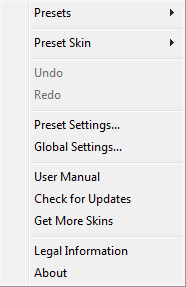
- Presets: opens the presets menu to manage presets.
- Preset Skin: opens the skins menu to choose the skin for the current preset and manage alternative skins for the software.
- Undo/Redo: undo or redo the latest modifications. This includes all changes made to the current preset settings such as MIDI or automation preferences.
- Presets Settings: open the presets settings window. It lets you change the skin, MIDI and automation settings for the current preset.
- Global Settings: open the global settings window. It lets you change the skin, MIDI and automation settings that are used by default in all instances of the plug-in (if not overridden by the current preset).
- User Manual: open this user manual.
- Check for Updates: opens up our website to let you check if any update for this software is available.
- Get More Skins: get more skins for this software.
- Legal Information: browse licensing and misc legal documents.
- About: displays the “about” dialog box.
Controls
Examples
Here are a few examples of typical controls you will encounter in the user interface of our plug-ins:
| slider | slider | knob | button | Text control |
|
|
 |
 |
|
|
Interacting with Controls
You can interact with the controls of the plug-in interface either with the mouse or the keyboard.
Setting the keyboard focus on a control (so that it responds to key strokes) may be automatic (when you pass the mouse over it it gets focus) or manual (you have to click on the control to set the focus on it). Note that all host applications behave differently regarding keyboard handling. In some applications you may not be able to use all keys described later in this manual to interact with our plug-ins. It is usually made obvious to you to know the active surfaces of the skin (the places where you can click with the mouse): the mouse cursor usually changes when you can do something on a control. In the default skins delivered with the plug-in, the cursor changes to a small hand or an arrow to tell you when your mouse is over an active control.
Mouse
Various mouse movements will let you interact with the controls:
| Mouse Interaction | Action |
|---|---|
| Left Click | Acquire focus and start dragging or push (button) |
| Left Click + Alt Key | Set the value to default |
| Left Double Click |
Acquire focus and launch the “fine
tuning” edit box (except button):
 |
| Right Click | Set the value to default |
| Mouse Wheel | Increment or decrement the position (focus required) |
| Mouse Drag | Change the control position depending on mouse movement (except button) |
Keyboard
All control widgets support the following keys (note that some of them are caught by the host and thus never forwarded to the control. For example in Steinberg Cubase SX you cannot use the arrow keys to control the plug-in):
Keys Common to All Controls
| Key | Action |
|---|---|
| Up Arrow | Small increment of the position (up or right) |
| Down Arrow | Small increment of the position (down or left) |
| Left Arrow | Same as Down Arrow |
| Right Arrow | Same as Up Arrow |
| Page Up | Large increment of the position (up or right) |
| Page Down | Large decrement of the position (down or left) |
| + | Small increment of the value of the control |
| - | Small decrement of the value of the control |
| d | Set to default value (same as mouse right click) |
| e |
Opens the 'fine tuning' window to precisely
set the parameter:
 |
| SHIFT | When the key is down, the fine tuning mode is on, and you can modify the value with better precision when moving the mouse, the mouse wheel or using the keyboard. Just release the key to get back to the normal mode. |
Keys Specific to Buttons
| Key | Action |
|---|---|
| Enter | Pushes the button |
Presets
To get started with the plug-in and discover its capabilities, a couple of factory presets are provided. You can also save your own presets and recall them later for other projects. Our plug-ins propose a full-featured preset manager to let you save, browse, organize and recall its presets.
The Presets Menu
The presets menu can be opened from the main menu or the main toolbar. It displays the list of presets available for the plug-in as well as commands to load, save or organize presets:
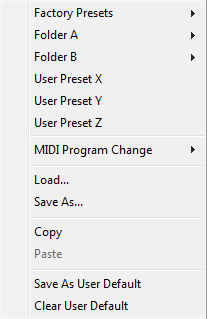
- Factory Presets: shows the list of factory presets delivered with the plug-in.
- "Folder A" to "User Preset Z": user presets and categories.
- MIDI Program Change: activate MIDI Program Change support (see below).
- Load: load preset from file.
- Save: save current state to last loaded user preset.
- Save As: save current preset to a file.
- Copy copy preset to the system clipboard.
- Paste paste preset from the system clipboard, if available.
- Save As User Default: save the current state as the default preset. This preset is used every time a new instance of the plug-in is created.
- Clear User Default: reset the default preset to its factory state: this makes the plug-in forgets the custom settings you might have saved as a default preset.
More about Presets
There are two types of presets: factory presets (read only) that are provided with the plug-in, and user presets that can be created and stored by the user.
The user presets are stored in a subdirectory of the documents folders of your profile ("Documents" on Mac, and "My Documents" on Windows): Blue Cat Audio/[Plug-in Name]/Presets. Each preset is stored as an individual file. You can create folders and subfolders in the Presets directory to classify your presets, as shown in the example below:

If you save a preset named "Default" in the root Presets directory, it will override the factory default preset (that's what "Save As Default" does). To restore the factory default preset, you can just remove this file or use the "Reset Default" command.
MIDI Program Change
It is possible to load presets remotely using MIDI "Bank Select" and "Program Change" messages. To enable this feature, select a MIDI channel to receive the events from in the MIDI Program Change menu item from the presets menu:
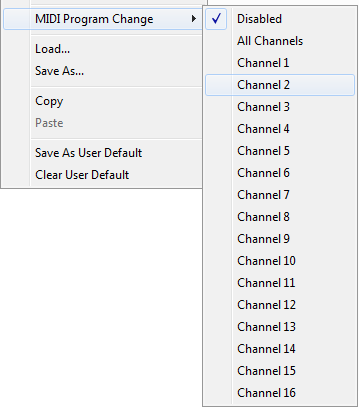
This setting is saved for each plug-in istance with your session but not in presets (except for the default preset, using the "Save as User Default command"). Once activated, the plug-in menu will display the bank number followed by the preset number for each preset:
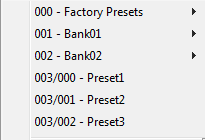
Every root folder is considered as a new bank, starting with the factory presets (bank 0). Program and bank numbers may change while you add folders and presets, so you should be careful when naming them if bank and program numbers matter to you. It is recommended to use folders to make this task simpler. As a side note, sub folders do not define additional banks (all presets contained in sub folders are associated with the current bank.
As specified by MIDI, bank select messages are not used until a program is actually selected.
MIDI Implementation note: the software supports all types of Bank Select methods. You can use either MIDI CC 0 or MIDI CC 32 to select banks. If both are used simultaneously, they are combined together so that you can use more banks (in this case CC0 is LSB and CC32 is MSB, and actual bank number is 128*CC0+CC32).
MIDI and Automation Control
Blue Cat's Re-Guitar can also be remotely controlled via MIDI using MIDI CC ("Control Change") messages or automation curves, if your host application supports it. It is possible to customize the channel, control numbers, range and response curve used for each parameter in the settings panel available from the main menu (see the Plug-in Settings chapter for more details).
MIDI and Automation Settings Menu
The main menu
Most skins also provide the ability to change MIDI and automation settings directly in the main user interface. Clicking on the control settings icon in the main toolbar opens the following menu:
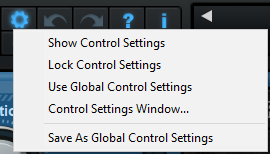
- Show Control Settings: show direct access to individual control settings for each parameter in the user interface (see next paragraph).
- Lock Control Settings: lock the current controls settings for MIDI and automation so that they remain unchanged when loading presets.
- Use Global Control Settings: ignore the current MIDI/automation settings and use the global settings instead.
- Control Settings Window: display the control settings window, to change control settings for all parameters.
- Save As Global Control Settings: save the current settings as global settings (used by default, when no specific MIDI/Automation setting has been set for the cuirrent preset).
Individual Control Settings
When this feature is activated using the "Show Control Settings" item in the MIDI and Automation Settings menu, dropdown menu buttons appears next to the main controls displayed by the plug-in:
Clicking on this button shows the MIDI/Automation settings menu:
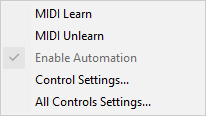
- MIDI Learn: launches MIDI learn mode for the control: touch your MIDI controller and the control will learn from it the MIDI channel and CC number. To end the learn mode, reopen this menu and deselect the option.
- MIDI Unlearn: deactivates MIDI control for this parameter.
- Control Settings: launches the advanced settings panel described below. This controls the settings for the current preset.
- All Control Settings: display the control settings window, with access to all parameters.
Advanced MIDI and Automation Settings
You can completely customize the way the plug-in is controlled by automation and MIDI. For a global view of all parameters at a time, you can use the Plug-in Settings window for the current preset which is available from the main menu.

MIDI Settings:
- Enable MIDI: enable/disable the MIDI control of the parameter.
- Channel: MIDI Channel for the parameter control. If set to 0, the plug-ins will accept Control Change Messages from all MIDI Channels (MIDI Omni mode).
- CC: Control Change Number.
- Learn: click on this button to activate the MIDI learn functionality. When it is activated, you can move your MIDI controller, and the plug-in will automatically set the MIDI Channel and CC Number.
MIDI and automation settings:
- Response: response curve of the MIDI or automation control: from very fast to slow control.
- Min: minimal value of the parameter when MIDI controlled or automated.
- Max: Maximum value of the parameter when MIDI controlled or automated.
Note: if the Min value is higher than the Max value, the response curve will be reversed: increasing the control value will decrease the parameter value.
Note: if you double click on the parameter text control boxes for the max and min values, a “fine tuning” edit box will appear and let you change the min and max values with more precision:

More
Check our online tutorial for more screenshots and more examples of our plug-ins user interfaces.
Blue Cat's Re-Guitar Parameters
All parameters described below can be automated and controlled via MIDI if your host application supports it. You can precisely define this behavior in the settings panels described later in this manual.
The parameters of this plug-in exposed for automation and MIDI control are described below:
| Name | Unit | Description |
|---|---|---|
| General | ||
| Bypass |
|
Bypass the effect. |
| Pickup / Acoustic Simulation | ||
| Pickup Enabled |
|
Enable pickup ∓ acoustic guitar simulation. |
| Pickup From |
|
Choose your currrent guitar pickup type (Single or Humbucker. Use "Single Coil Bright" for brighter single coil pickups. |
| Pickup To |
|
Choose the type of pickup or acoustic guitar you want to emulate. For multi pickup simulations (like Single Bridge+Mid), use the bridge pickup on your guitar. |
| Pickup Mix | % | Amount of pickup/acoustic guitar simulation vs dry input signal. |
| Custom X | % | Horizontal position of the cursor for custom electric or acoustic simulations. |
| Custom Y | % | Vertical position of the cursor for custom electric or acoustic simulations. |
| Hollow Body | ||
| Body Enabled |
|
Enable hollow body simulation. |
| Body Thickness | mm | Thickness of the virtual hollow body (active only if body amount is not 0). |
| Body Amount | % | Amount of body simulation. |
| Adjust | ||
| Brightness | % | Brightness correction control to adjust the simulation to your pickups or modify the tone of the simulations. |
| Gain | dB | Adjust the gain to compensate potential volume loss or increase depending on your pickups and the selected simulation. |
| Virtual Pots | ||
| Volume |
|
Guitar volume pot simulation. |
| Tone |
|
Guitar tone pot simulation. |
Plug-in Settings
In addition to the controls offered in the main user interface, Blue Cat's Re-Guitar has various settings that let you fine tune the behavior of the plug-in. You can choose to change these settings either for the current preset or globally for all instances of the plug-in.
The Global Settings Window
The settings available in this window apply to all instances of the plug-in, for all presets, if not overridden in the presets settings. Consider these settings as “default” settings.
General
You can change the default skin for all instances of the plug-in: write the skin file path in the text edit box or click on the button to open a file chooser dialog. If you have several instances of the plug-in opened in your session, you will have to re-open the user interfaces of these plug-ins to see the skin change.
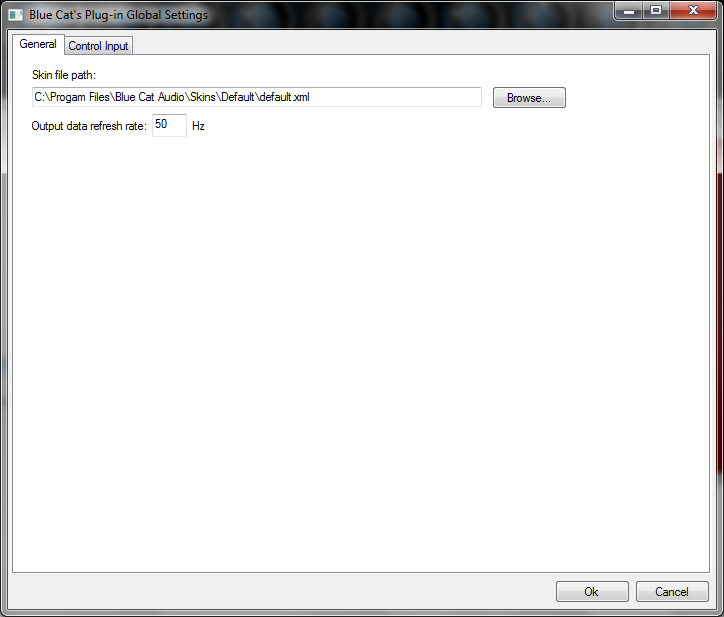
The output data refresh rate can also be customized for all instances of the plug-in. It controls the refresh rate of non-audio data produced by the plug-in (parameters, curves...). It also controls the refresh rate of output MIDI CC messages or output automation data. The higher the refresh rate, the better precision, but also the higher cpu usage (some host applications may also have trouble recording MIDI data at high refresh rates). The default value is 50 Hz.
Global Control Input Settings (MIDI and Automation)
The plug-in offers a couple of settings that affect the way it is controlled by MIDI messages or automation. While the first settings only apply to MIDI control, the "Control Response", "Min" and "Max" settings apply to both automation and MIDI control.
For each parameter you can define a default MIDI channel and CC number. You can then control the plug-in with an external MIDI controller or one of our plug-ins that generate MIDI messages.
The settings below are available for each plug-in parameter.
MIDI Settings:
- Enable MIDI: enable/disable the MIDI control of the parameter.
- Channel: MIDI Channel for the parameter control. If set to 0, the plug-ins will accept Control Change Messages from all MIDI Channels (MIDI Omni mode).
- CC: Control Change Number.
- Learn: click on this button to activate the MIDI learn functionality. When it is activated, you can move your MIDI controller, and the plug-in will automatically set the MIDI Channel and CC Number.
MIDI and automation settings:
- Response: response curve of the MIDI or automation control: from very fast to slow control.
- Min: minimal value of the parameter when MIDI controlled or automated.
- Max: Maximum value of the parameter when MIDI controlled or automated.
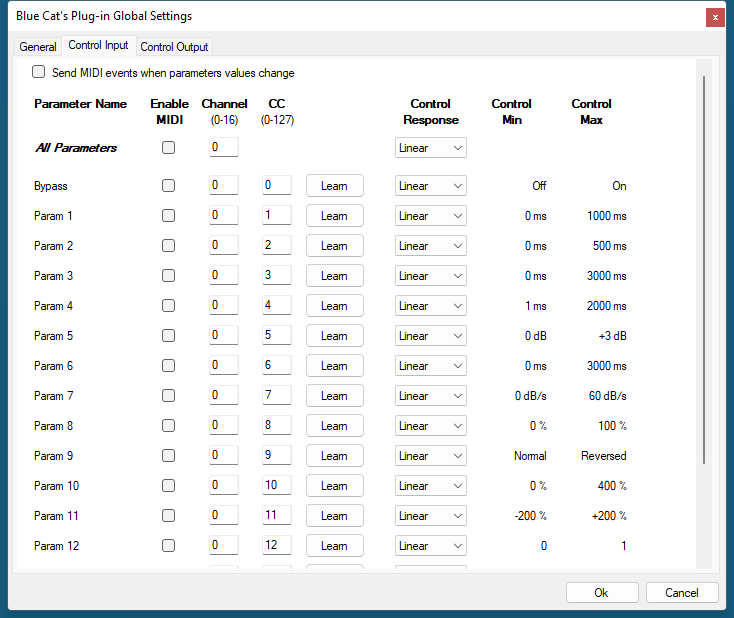
Note: if the Min value is higher than the Max value, the response curve will be reversed: increasing the control value will decrease the parameter value.
Note: if you double click on the parameter text control boxes for the max and min values, a “fine tuning” edit box will appear and let you change the min and max values with more precision:

"Send MIDI events when parameters values change": activate this option when using a control surface that accepts MIDI events as input. MIDI messages will be sent to the output of the plug-in when the user change the parameters values in the user interface, to keep the software and the controller in sync. MIDI is only sent for parameters that are activated for MIDI control.
The Current Preset Settings Window
In this window you can change the settings for the current preset of the current instance of the plug-in only.
Preset Skin
You can choose to use the global skin setting or to change the skin for the current preset. This way you can have different skins for different instances of the plug-in in the same session in order to differentiate them.
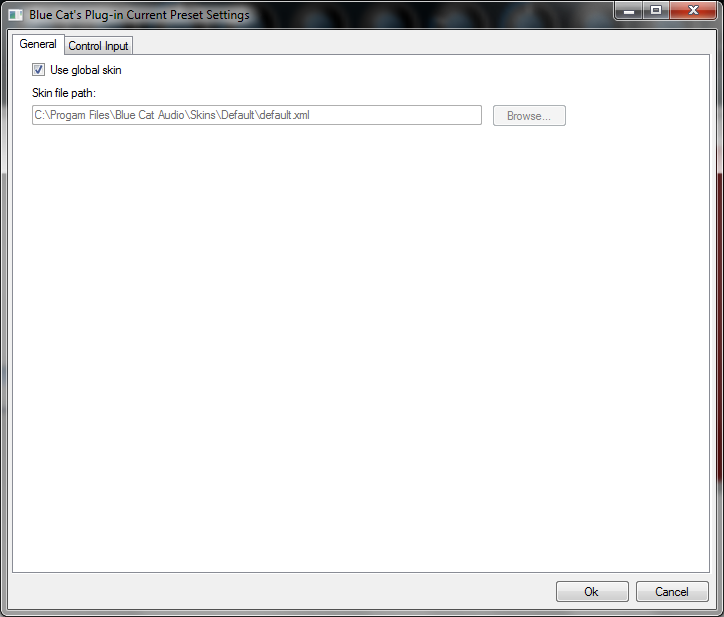
Preset Control Input Settings (MIDI and Automation)
Use the global settings or override them for the current preset. The parameters are the same as for the global input settings.
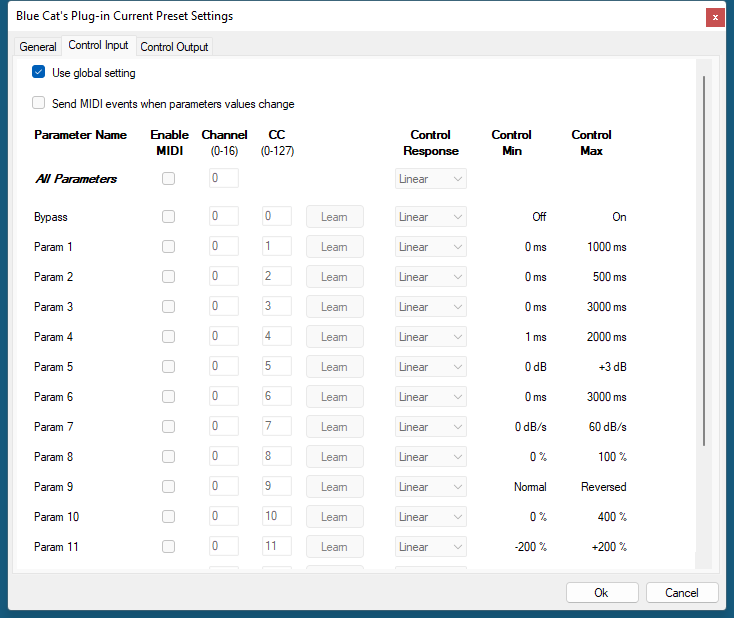
About Skins
Blue Cat's Re-Guitar integrates Blue Cat's skinning engine that allows you to customize the user interface. You can download alternate skins for your plug-in at the following address:
If you don't find a skin that fits your need or if you want a custom one, you can choose to create your own skin.
Choosing the Skin
There are two ways to select the skin of your plug-in: you can change the default (or 'global') skin, or change the skin for the current preset only (either in the preset settings page or from the main menu). The global skin applies to all plug-in instances (choose this one if you want to use the skin used by default, regardless of the session or preset), whereas the current preset skin only applies to the current preset of the current plug-in instance (use this one if you want to change only the skin for the current session/preset).
Note: in some host applications, the plug-in window won't resize automatically when you choose a skin with a different size. In this case, just close the window and re-open it: it will be displayed with the right size.
The Skins Menu
The skins menu can be opened from the main menu. It displays the list of skins available for the plug-in as well as commands to manage the skin used by default when no preset skin has been selected:
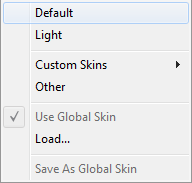
- First Section - Factory Skins: shows the list of factory skins delivered with the plug-in ("Default" and "Light" in this example).
- Second Section - User Skins: shows the list of user skins that have been installed in the Documents Skins folder for the plug-in (see below).
- Use Global Skin: use the global skin for the current preset/session (unloads any custom skin previously selected for the current preset).
- Load: opens a file browser dialog to manually select the skin from the file system.
- Save As Global Skin: use the current preset skin as the global skin (loaded by default if no preset skin has been defined).
Installing User Skins
To select user skins directly from the skins menu, install them in the "Skins" directory available in the plug-in's documents folder:
[Your Documents Folder]/Blue Cat Audio/[Plugin Name]/Skins/
The skin engine will scan this folder for new skins (xml files) and display them in the menu. The skin files should be in the root skins folder or in a subdirectory inside this folder: subdirectories are not scanned recursively.
Other Methods to Select Skins
You can also select the skins in the settings panels available from the main menu:
The global skin (used by default if no preset skin has been selected) can be changed in the global settings pane. The current preset skin can be changed in the preset settings page .
Create a Custom Skin
You can create custom skins for your plug-in in order to adapt it to your exact needs. You can change its look and feel and make it completely integrated in your virtual studio!
Just read the Blue Cat's Skinning Language manual and download the samples for the tutorial on http://www.bluecataudio.com/Skins. You can get ready to create your own skins in a few minutes. You can then share your skins on our website.
More...
This manual only covers the main aspects of Blue Cat's Re-Guitar. Our website offers many additional resources for your Blue Cat's Re-Guitar plug-in. It is constantly updated, so keep an eye on it!
Updates
As you can see in the history log below, we care about constantly updating our products in order to give you the latest technology available. Please visit our website often to check if Blue Cat's Re-Guitar has been updated, or subscribe to our Newsletter to be informed of the latest news about our products.
Note: minor version updates are available from the same location as the original full version download (link received by email upon purchase). The demo version publicly available on our website will not let you register.
You can also follow us on twitter, facebook and instagram for almost real time updates notification, and subscribe to our YouTube channel to watch the latest videos about our software.
Versions History
V1.3 (2023/07/18) |
|
V1.21 (2022/12/12) |
|
V1.2 (2021/11/02) |
|
V1.1 (2020/05/28) |
|
V1.0 (2019/03/12) |
First version |
Thanks again for choosing our software!

See you soon on www.bluecataudio.com!

